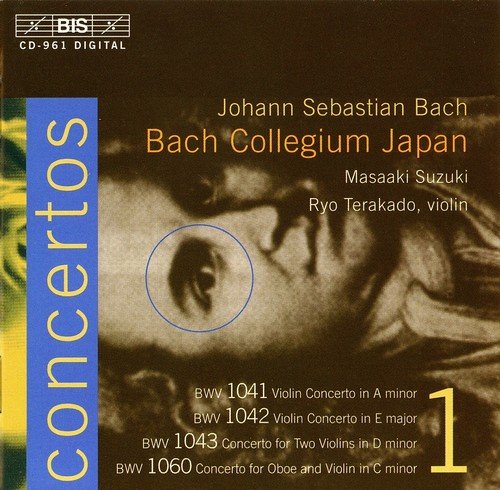
Ryo Terakado, Marcel Ponseele, Bach Collegium Japan, Masaaki Suzuki - J.S. Bach: Violin Concertos, Vol.1 (1999)
BAND/ARTIST: Ryo Terakado, Marcel Ponseele, Bach Collegium Japan, Masaaki Suzuki
- Title: J.S. Bach: Violin Concertos, Vol.1
- Year Of Release: 1999
- Label: BIS
- Genre: Classical
- Quality: FLAC (image+.cue,log,scans)
- Total Time: 59:19
- Total Size: 366 Mb
- WebSite: Album Preview
Tracklist:
Concerto For Two Violins And Strings in D Minor, BWV 1043 (14:50)
1 I. Vivace 3:29
2 II. Largo Ma Non Tanto 6:44
3 III. Allegro 4:29
Violin Concerto In A Minor, BWV 1041 (13:50)
4 I. [-] 3:44
5 II. Andante 6:24
6 III. Allegro Assai 3:32
Violin Concerto In E Major, BWV 1042 (16:24)
7 I. Allegro 7:42
8 II. Adagio 5:57
9 III. Allegro Assai 2:34
Concerto for Oboe, Violin and Strings in C Minor (13:01)
10 I. Allegro 4:39
11 II. Adagio 4:56
12 III. Allegro 3:17
Performers:
Ryo Terakado (violin solo)
Natsumi Wakamatsu (violin II solo on tracks: 1 to 3)
Marcel Ponseele (oboe on tracks: 10 to 12)
Bach Collegium Japan
Masaaki Suzuki (harpsichord & direction)
Concerto For Two Violins And Strings in D Minor, BWV 1043 (14:50)
1 I. Vivace 3:29
2 II. Largo Ma Non Tanto 6:44
3 III. Allegro 4:29
Violin Concerto In A Minor, BWV 1041 (13:50)
4 I. [-] 3:44
5 II. Andante 6:24
6 III. Allegro Assai 3:32
Violin Concerto In E Major, BWV 1042 (16:24)
7 I. Allegro 7:42
8 II. Adagio 5:57
9 III. Allegro Assai 2:34
Concerto for Oboe, Violin and Strings in C Minor (13:01)
10 I. Allegro 4:39
11 II. Adagio 4:56
12 III. Allegro 3:17
Performers:
Ryo Terakado (violin solo)
Natsumi Wakamatsu (violin II solo on tracks: 1 to 3)
Marcel Ponseele (oboe on tracks: 10 to 12)
Bach Collegium Japan
Masaaki Suzuki (harpsichord & direction)
Founded in 1990 by its then-current organist, harpsichordist, and conductor Masaaki Suzuki, the Bach Collegium Japan is one of Japan's first period-practice Baroque ensembles. Focusing primarily on the works of J.S. Bach, the ensemble has emerged as an important artistic presence not only in Japan but across the globe, producing consistently superior performances backed by a well-informed and intellectual understanding of Bach's music and its historically accurate performance. This album features four of Bach's most recognizable works, his concertos for violin(s). Soloist Ryo Terakado makes a strong argument in the liner notes for treating these works less like concertos and more like chamber music, wherein the importance of the soloist's part is tantamount to the orchestra's. As such, the size of the accompanying orchestra on this album is as small as possible, yet produces a sound as full and rich as other ensembles that play with significantly more musicians. The blurring of the line between soloist and orchestra works well to a point, but there are still moments when most listeners would prefer that the solo line rise up above the orchestra a little more. The performance aesthetic of this album sometimes makes this difficult. Whether this is a success by capturing a more homogenous chamber music sound, or a detriment for not distinguishing the solo line, is a determination that individual listeners will have to make for themselves.
Classical | FLAC / APE | CD-Rip
As a ISRA.CLOUD's PREMIUM member you will have the following benefits:
- Unlimited high speed downloads
- Download directly without waiting time
- Unlimited parallel downloads
- Support for download accelerators
- No advertising
- Resume broken downloads


